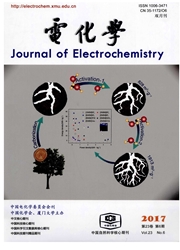

 中文摘要:
中文摘要:
本文采用不同pH值的KOH溶液对WC材料进行了不同时间的碱处理,并以该WC为载体通过微波加热还原法制备PtRu/WC复合材料.采用XRD对材料进行结构表征,通过循环伏安法和计时电流法测试电极对甲醇的电催化氧化性能.结果表明,经不同碱性条件处理的WC材料表面更易于铂钌的负载,其中经强碱(pH=14)的KOH溶液处理后可在WC表面得到结晶度最好的铂钌合金,且所得电催化剂PtRu/WC电极的性能最佳,而经碱处理5 h的WC负载的PtRu/WC电极对甲醇氧化的效果最优.
 英文摘要:
英文摘要:
The surface of tungsten carbide (WC) was treated by potassium hydroxide (KOH) at different pH values for different time. The PtRu/WC composite was prepared by microwave-assisted polyol method. The phase structure of PtRu/WC composites were characterized by XRD. The electrocatalytic activity was tested by cyclic voltammetry and chronoamperometry. The results indicated that with different pH treatments WC became more readily supported on PtRu. When treating WC in KOH at pH = 14, PtRu exhibited the best degree of crystallinity on WC surface, leading to the highest electrocatalytic activity of PtRuAVC. Moreover, the optimized activity of PtRu/WC towards methanol oxidation was obtained by pretreating WC in KOH for 5 h.
 同期刊论文项目
同期刊论文项目
 同项目期刊论文
同项目期刊论文
 期刊信息
期刊信息
